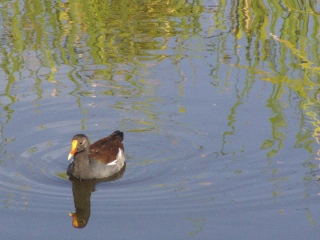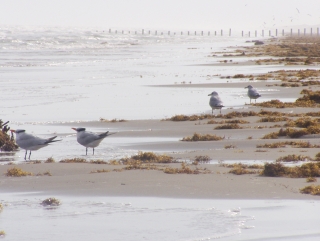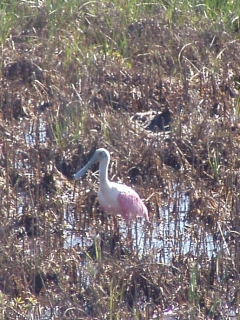 Months later, we are driving down the Gulf coast of Texas, which we now know is a mecca for migratory birds, and I nearly cause my husband to veer off the road and into a marshy ditch by screaming, “Oh my God it’s a ROSEATE SPOONBILL!!” at the top of my lungs.
Months later, we are driving down the Gulf coast of Texas, which we now know is a mecca for migratory birds, and I nearly cause my husband to veer off the road and into a marshy ditch by screaming, “Oh my God it’s a ROSEATE SPOONBILL!!” at the top of my lungs.
Witnessing all of this from the back seat is our good friend Sarah, whom we just picked up from the Houston airport.
“You guys totally lied to me. You are way more into this than you let on.”
Can you blame us? We have just come from an “Important Bird Area”. Two, in fact. South Padre Island and the Padre Island National Seashore have both been proclaimed as “Globally Important” by the American Bird Conservancy. Perfect places for us novice birders to practice our new obsession.
 Being novice birders, we need to focus on distinctive species and types. The larger the better. Brown and White Pelicans, I can spot those. Herons – easy, and often color-coded. Blue herons are blue. Reddish egrets are red. Crested Caracaras – gaudy and unmistakable, even from a moving vehicle. Michael is getting quite good at spotting various raptors from the road. I can always tell when he’s looking when we start to stray into oncoming traffic. I don’t know if we’ll ever be able to tell the difference between a sanderling and a snowy plover, although we spent an entire afternoon at the beach trying.
Being novice birders, we need to focus on distinctive species and types. The larger the better. Brown and White Pelicans, I can spot those. Herons – easy, and often color-coded. Blue herons are blue. Reddish egrets are red. Crested Caracaras – gaudy and unmistakable, even from a moving vehicle. Michael is getting quite good at spotting various raptors from the road. I can always tell when he’s looking when we start to stray into oncoming traffic. I don’t know if we’ll ever be able to tell the difference between a sanderling and a snowy plover, although we spent an entire afternoon at the beach trying.
Perhaps the highlight of our birding afternoon in South Padre Island was witnessing firsthand, the “extremely long bill” of the aptly-named Long-Billed Curlew. In case you had any doubts, the picture in the Sibley Field Guide points to the disproportionately long proboscis and notes, this is an “extremely long bill.”
 Shorebirds are fun. They are usually in plain sight and let you get relatively close before they fly away, leaving us flipping through the guide book wondering if that was a Royal or a Caspian Tern. Was the beak really red? Or more like an orange-y red? Why can’t they just stay still?
Shorebirds are fun. They are usually in plain sight and let you get relatively close before they fly away, leaving us flipping through the guide book wondering if that was a Royal or a Caspian Tern. Was the beak really red? Or more like an orange-y red? Why can’t they just stay still?
Whenever I find myself tiptoeing and creeping up to an unsuspecting fowl with my binocs and bird book, I can’t help but think of the pencil-thin, hook-nosed, birdwatching spinster from the old Woody Woodpecker cartoons.
Is birding for nerds?
Hardly. While we were celebrating Thanksgiving in Galveston, we read several newspaper articles in the local and Houston papers about how the area was courting birders (and their wallets) to the Island. Birders apparently are very good for business. Birders are no longer seen as solitary individuals who sneak off into the woods for days; they are couples, families, groups of friends who like to look at birds and then go out to dinner, stay at nice hotels and occasionally upgrade their birding equipment. Texas, particularly the Rio Grande Valley, is crazy about people that are crazy about birds.
 Birding appeals to the collectors in us. Like stamps in our prized National Parks Passport Book, each new bird we see is another way to remember this fantastic journey across the states. Another way to catalogue the places we’ve seen and walks we’ve taken. We saw our first flock of white ibises in Galveston, a faint glimpse of a California condor in the Grand Canyon, every time we see a Bald Eagle is a moment of reverence. The Roseate Spoonbill will always remind me to use my quiet voice when in the car.
Birding appeals to the collectors in us. Like stamps in our prized National Parks Passport Book, each new bird we see is another way to remember this fantastic journey across the states. Another way to catalogue the places we’ve seen and walks we’ve taken. We saw our first flock of white ibises in Galveston, a faint glimpse of a California condor in the Grand Canyon, every time we see a Bald Eagle is a moment of reverence. The Roseate Spoonbill will always remind me to use my quiet voice when in the car.